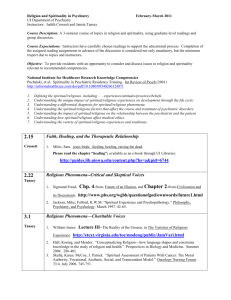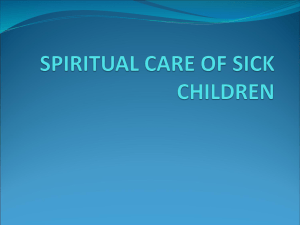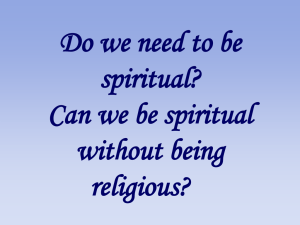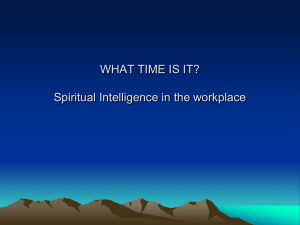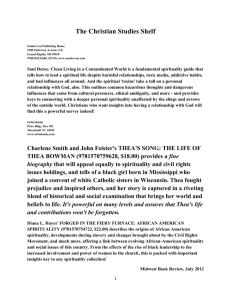validation of spirituality in alcoholics anonymous as a psychiatric
advertisement
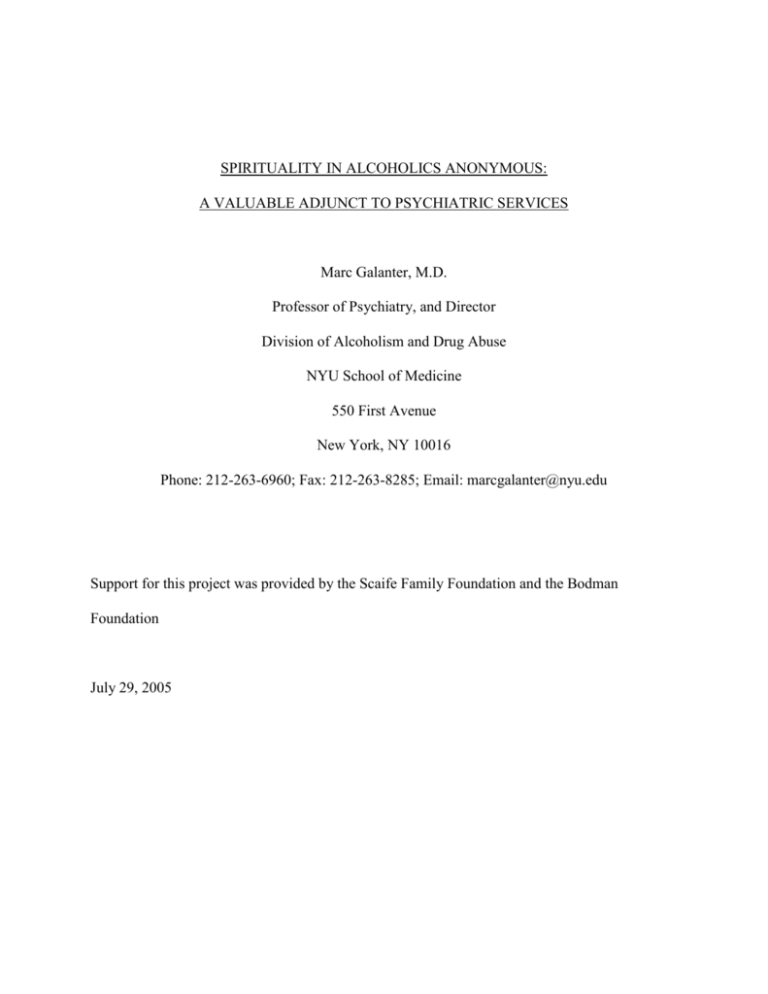
SPIRITUALITY IN ALCOHOLICS ANONYMOUS: A VALUABLE ADJUNCT TO PSYCHIATRIC SERVICES Marc Galanter, M.D. Professor of Psychiatry, and Director Division of Alcoholism and Drug Abuse NYU School of Medicine 550 First Avenue New York, NY 10016 Phone: 212-263-6960; Fax: 212-263-8285; Email: marcgalanter@nyu.edu Support for this project was provided by the Scaife Family Foundation and the Bodman Foundation July 29, 2005 Alcoholics Anonymous dates back to 1935 when Bill W, a layman, experienced a spiritual reawakening that led him on a path toward recovery from alcoholism. Since that time, countless addicted people have attributed similar relief to this movement. AA is called a spiritual fellowship by its members, but we are only now beginning to understand the mechanisms that underlie this aspect of recovery. The validation of spirituality, a seemingly enigmatic term, must ultimately be based on psychological and physiologic findings. An initial aspect of this task lies in defining spirituality in empirical terms, as was succinctly done by Puchalski et al. as “that which gives people meaning and purpose in life.” They amplify on this by pointing out that it can be achieved “through participation in a religion, but can be much broader than that, such as, belief in God, family, naturalism, rationalism, humanism, and the arts” (1). The use of this term with this connotation is of surprisingly recent origin. Anthropologists have typically applied the word “spiritual” to much more concrete aspects of religious and shamanic practice. Its current usage can be understood to have derived from a number of sources, some of them particular to recent trends in American culture over the last half century. Acceptance of an ecumenical religious orientation has led to an appreciation that the formalities of ritual practice may be less important than the values that many religious denominations hold in common. Acceptance of the cultural basis of practices like meditation, with its relationship to Asian philosophies, and complementary medicine, has added another dimension to this concept. The emergence of AA itself as a potent vehicle for personal transformation has also been influential, as it has brought the term to the attention of both the general public and mental health professionals. All these have led to acceptance by the general 1 public of the various spiritually oriented philosophies and practice for recovery from illness that have emerged outside of the domain of established biomedicine. Most psychiatric modalities are associated with a singular mechanism: psychopharmacology with physiology, cognitive behavioral techniques with behaviorist psychology, psychodynamic therapy with intrapsychic and interpersonal conflict. Spirituality, however, has been termed a latent construct: Like the concept of personality, it cannot be understood or observed from a single perspective, but rather inferred from multiple component dimensions. As such, we can examine here its multiple, empirically-grounded components: psychology, physiology, and clinical psychiatry. Psychology A psychological model of spiritual renewal was framed as early as the turn of the last century by William James who gave illustrations of its effectiveness as a euphoriant and vehicle for change in his book The Varieties of Religious Experience. We recently reviewed how experiences of spiritual renewal produce measured improvements in psychopathology among members of both zealous religious sects and born-again evangelicals. These improvements were reflected in quantitative changes on psychometric measures and frequency of drug use. They were found to be lasting, and transformative of affective status, social adaptation, and occupational activity (2). The placebo response sheds light on the value of belief in a transcendent entity, be it a pill or a traditional healer -- and this comes about in the absence of physiologic intervention. The prevalence of response to placebo antidepressants in study populations, for example, is more than half that among subjects responding to the active drug (3), and imaging studies have delineated innate physiologic changes that are correlates of the placebo response (4). 2 Such findings underline the fact that there is a domain of psychological function which can operate outside currently prevalent professional psychosocial and pharmacologic clinical practice. Given this, it is reasonable to point out that our current psychiatric interventions may not fully utilize the transformative nature of spiritually-oriented belief as an effective modality that can be employed for its clinical utility. Instead, spiritual renewal has come to be seen as separate from mainstream care, typically under the rubric of alternative and complementary medicine. It is these latter techniques that many ill people turn to in the face of technology-based medicine. Physiology Physiologic research suggests that spirituality may be relevant to the healing of psychic disorders. Individuals who score higher on personality traits related to spiritual transcendence have been found to have characteristic activity in certain serotonergic brain sites (5), suggestive of individual physiologic variations in response to spiritually-oriented care. The close relationship between the symbolic thought and the dream symbolism is characterized by the activation of certain brain centers and concomitant deactivation of others (6); this suggests an association between spiritual metaphor and neural function. Response to the social context of spiritual conversion may also be correlated in neurophysiologic function. A person in a social setting in which a spiritually-oriented perspective is presented with intensity may be drawn in to adopt that perspective. Correlates of such social compliance in thinking have been found to be associated with functional changes in an occipital-parietal network (7). The many studies on physiologic correlates of meditation, itself rooted in spiritually-oriented subcultures, can be cited as well. Electroencephalographic changes, for example, have been observed among long-term Buddhist meditators (8), even subsequent to their periods of meditation. 3 Addiction Psychiatry The experience of Bill W at the inception of AA, in which he was “caught up in an ecstasy which there are no words to describe,” cannot be easily researched. And framing a methodology for studying the role of AA-based recovery is difficult on other counts as well. Twelve-Step fellowships require anonymity of their members, and are oriented toward the primacy of members' needs beyond any research objectives that investigators might propose. Because of this, most outcome studies on recovery through AA have been tied to follow-up on patients engaged in professionally based treatment who also attend AA meetings. Uncontrolled assessments of the Twelve-Step “Minnesota Model” for long-term residential rehabilitation in a professionally-directed setting have shown promising results, but one major study related to AA based recovery stands out because it entailed randomization and experimental controls. A large-scale evaluation by the National Institute on Alcohol Abuse and Alcoholism, Project MATCH, was carried out with careful long-term follow-up. It revealed that Twelve-Step facilitation, a professionally-grounded modality designed to promote AA attendance, was at least as effective as motivational and cognitive techniques (both of which were developed from empirically-grounded research models), and it was more effective than they were in achieving long-term abstinence (9). Professional treatment of substance-impaired physicians also offers an insight into AA’s clinical value, as long-term abstinence has important public health implications for this population. One sample of these physicians, previously in AA-based professional treatment, reported Twelve-Step membership to be the principal reason for their long-term abstinence and recovery (Galanter), and among a sample of physicians selected at random among those monitored by a Committee on Physicians Health, 97% with prior Twelve-Step experience, 4 continued with it during their monitoring period. Research on the role of spirituality in the recovery process independent of professional management has been modeled empirically, and the association between AA involvement and on this basis improved outcome has been demonstrated (10). In any case, there is no doubt that membership in AA, avowedly related to its spiritual grounding, has now been undertaken by millions of addicted people who credit it for their addiction recovery. The Twelve-Step experience creates a sense of communality, as distinguished from the conventional institutional context, and this is an important aspect of its spiritual nature. The fellowship’s orientation to mutual support creates a shared sense of renewal that validates the behavioral requirement of recovery, namely, maintaining abstinence. For addicts as a group, it has also sustained the integrity and structure of AA as a movement. Impaired physicians, for example, have established a supportive network through AA-related Caduceus groups and the organization International Doctors in AA. The clinical benefit of AA mutuality has been demonstrated in controlled studies on enhanced outcome in addiction treatment programs (11), decreased need for professional staffing in alcohol outpatient rehabilitation (12), and on addiction treatment with general psychiatric care for the dually diagnosed (13). Broadly speaking, the role of spirituality in recovery from substance dependence relates to the promotion of members’ achieving a meaningful life. Recovery approaches such as the use of family therapy, meditation, and religious revivalism, all illustrate the value of infusion of such personal meaning into the recovery process. All these approaches are associated with the factors often termed non-specific that underlie the curative effects seen across different schools of psychotherapy. 5 What remains to be sorted out are the many ways in which spirituality, however difficult to pin down empirically and however differently experienced in the lives of many people, can be fully employed in the context of professionally-grounded psychiatric services (and general psychiatric service as well). It is clear, however, that multidisciplinary approaches to this latent concept can enhance our understanding of such opportunities. This may represent a difficult task to undertake in the domain clinical care, but in the meantime AA, a spiritual fellowship, is clearly valuable as an adjunct to professional psychiatric services. 6 1. Puchalski CM, Dorff ED, Hendi IY: Spirituality, religion, and healing in palliative care. Clinical Geriatric Medicine 20: 689-714, 2004 2. Galanter M: Spirituality and the Healthy Mind: Science, Therapy and the Need for Personal Meaning. New York: Oxford University Press, 2005 3. Walsh BT, Seidman SN, Sysko R, Gould M: Placebo response in studies of major depression. Journal of the American Medical Association 287: 1840-1847, 2002 4. Leuchter AF, Cook IA, Witte EA, Morgan M, Abrams M: Changes in brain function of depressed subjects during treatment with placebo. American Journal of Psychiatry 159: 122-129, 2002 5. Borg J, Bengt A, Soderstrom H: The serotonin system and spiritual experiences. American Journal of Psychiatry 160: 1965-1969, 2003 6. Hobson JA, Pace-Schott EF, Stickgold R: Dreaming and the brain: toward a cognitive neuroscience of conscious states. Behavioral Brain Sciences 23:793-1121, 2000 7. Berns GS, Chappelow J, Zink CF, et al: Neurobiological correlates of social conformity and independence during mental rotation. Biological Psychiatry 2005, in press 8. Lutz A, Greischar L, Rawlings N, et al: Long-term meditators self-induce high-amplitude gamma synchrony during mental practice. Proceedings of the National Academy of Sciences USA 101: 16369-16373, 2004 9. Project MATCH Research Group: Matching alcoholism treatments to client heterogeneity: Project MATCH three-year drinking outcomes. Alcoholism Clinical and Experimental Research 22: 1300-1311, 1998 7 10. Owen PL, Slaymaker V, Tonigan JS, et al: Participation in Alcoholics Anonymous: intended and unintended change mechanisms. Alcoholism Clinical and Experimental Research 27: 524-532, 2003 11. Morgenstern J, Labouvie E, McCrady BS, et al: Affiliation with Alcoholics Anonymous after treatment: a study of its therapeutic effects and mechanisms of action. Journal of Consulting and Clinical Psychology 65: 768-777, 1997 12. Galanter M, Castaneda R, Salamon I: Institutional self-help for alcoholism: clinical outcome. Alcoholism Clinical and Experimental Research 11:424-429, 1987 13. Miner CR, Rosenthal RN, Hellerstein DJ, et al: Prediction of compliance with outpatient referral in patients with schizophrenia and psychoactive substance use disorders. Archives of General Psychiatry 54: 706-712, 1997 MG/kf spirituality in AA February 15, 2016 8


